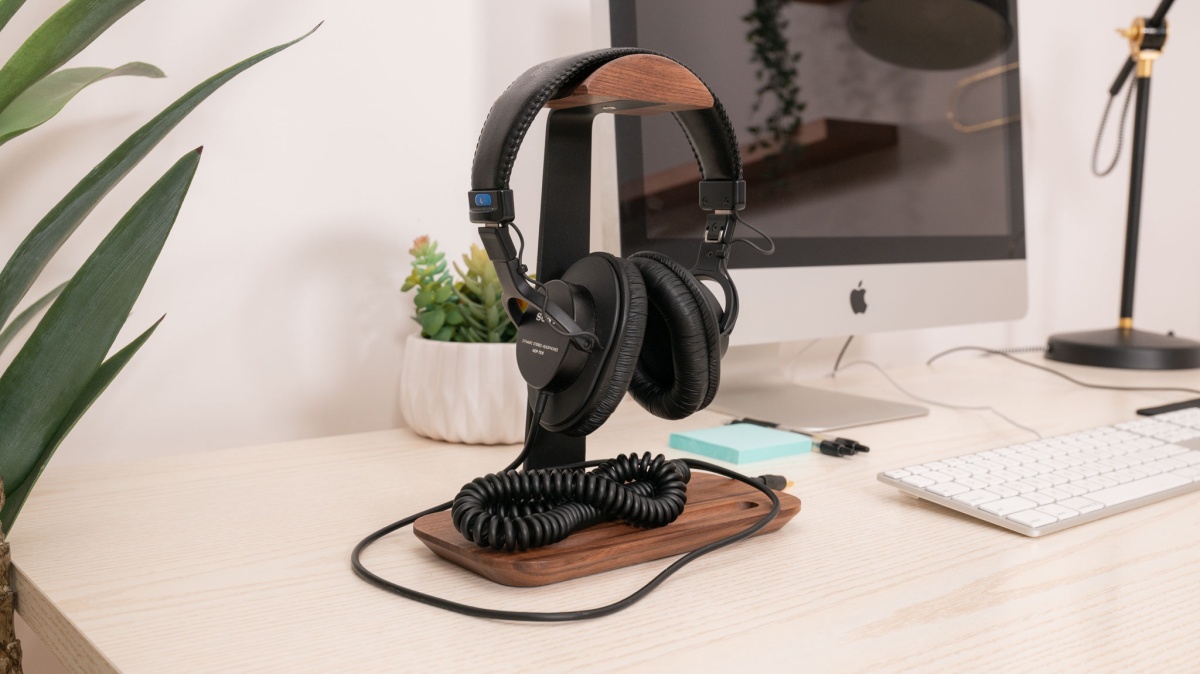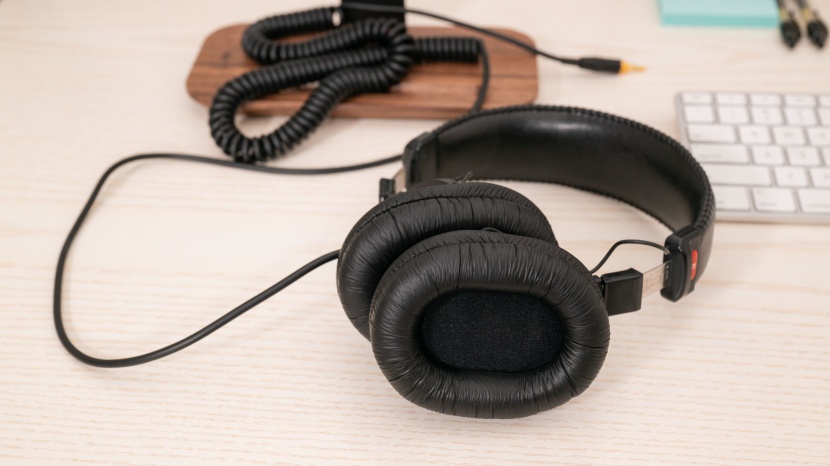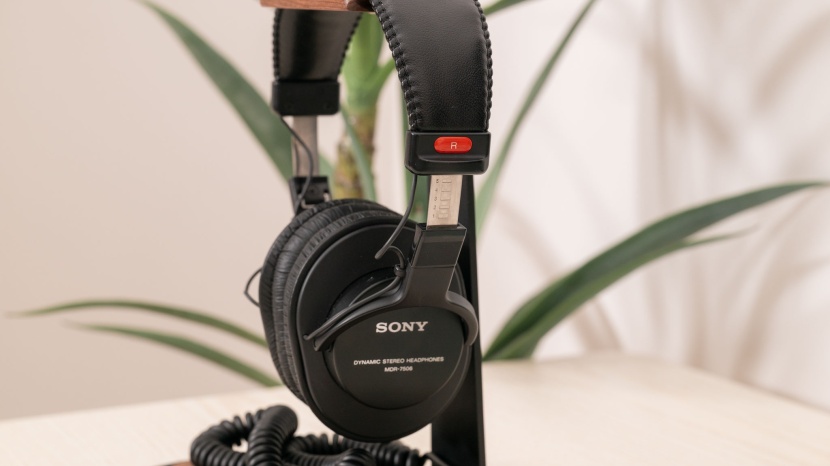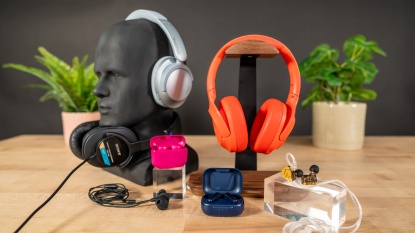
Our Verdict
Our Analysis and Test Results
The MDR-7506 are a lightweight, budget pair of studio reference headphones that perform well for their price point.
Sound Quality
While the MDR-7506 has a generally flat frequency response and is clear and accurate across it, our testers found the highs to be “shouty” and harsh at times. Part of the issue here is that these headphones run a little quieter out of the box than most, and as a result of getting the gain to a listenable level, we saw some degradation of the treble frequencies (4khz+). However, it's worth noting that these headphones are at a considerably lower price point than their competitors, and despite this small drawback, they perform quite well otherwise.
The overall sound profile of these headphones is exceptionally neutral and balanced. Nothing is particularly emphasized or subdued. Our expert ear, Gena, notes that although they are not the best, these headphones have “a satisfying level of detail” across music genres. The low end (60Hz to 250Hz) is clean and present without being overwhelming, and while there is punch and power to the bass, it doesn't get boomy and distorted like other headphones can at this price point. “Savage” by Megan Thee Stallion does a good job at representing how these headphones sound fun and accurate, but maybe lack the “most nuanced details” and punch that you might hear while wearing more bass-friendly headphones.
These headphones have excellent midrange (500Hz to 2kHz) reproduction for the price. If there's one key takeaway, this is it. This is why these headphones have been a mainstay in the studio reference space since 1991. Vocals feel vibrant, forward, and unveiled. The crescendo at the 1:30 mark in the song “Off My Mind” by Joe P is handled with ease. Our tester notes that this “dynamic shift feels natural” and unforced. There's space and clarity here that many headphones, even at higher price points, struggle to execute well. This is why you still see these headphones on film and TV productions (and what would make them a solid choice for podcast and audiobook playback): human voices are full, textured, and clear.
The treble frequencies (4khz+) are where these headphones struggle the most. There's detail here, but almost too much detail. Our tester notes that highs can be “too discernible or over-emphasized,” leading to harshness and occasional sibilance. Songs like “thank u, next” by Ariana Grande and “obsessed” by Olivia Rodrigo are vocal-forward and fun, but the top end of the tracks feels off and sometimes uncomfortable. This is worth noting, especially if treble-heavy genres like classical and jazz are in your heavy rotation.
Overall, these headphones are a nice compromise between price and performance, making them a great Goldilocks budget choice. They have tight, accurate bass, an excellent midrange response, and a high-definition treble that suffers from occasional harshness.
Soundstage
One of the hallmarks of live music is the sense of being surrounded, with each instrument clearly defined in space. You can hear the guitar to your left, the vocals centered, and the bass placed either far in the back or upfront.
The MDR-7506 do a decent job at creating this sense of spatiality. Songs like “Southern Nights” by Glen Campbell and “Colder Than You” by Canaan Smith have an airiness between the layers of instruments and vocals that allows the listener to parse through the soundscape and focus on different parts of the mix.
The results closely follow our expert ears' findings. While the bass (0hz to 250Hz) is present and punchy, it is not as dominant as most modern consumer earbuds and headphones. The mids (250Hz to 2kHz) followed our House Curve extremely tightly, validating how impressed we were with their performance. The treble response (2khz+) falls off pretty sharply, as we observed during our expert listening sessions.
While, for the price, the MDR-7506 performs well, but they have some limitations. Many listeners of more bass-centered genres like EDM, rap, and pop may find these headphones underwhelming, and likewise, treble-heavy music lovers might find them harsh and too bright. However, the Goldilocks zone of these headphones is the mids. Folk and vocal-forward genres shine, as do media that rely heavily on the human voice, like podcasts and audiobooks. Specifically, those listeners who are involved with media production in some capacity and want a balanced set of affordable headphones for playback may enjoy the 7506s.
User Experience
The MDR-7506 are a lightweight, no-frills pair of budget studio reference headphones.
Comfort
At 304 grams, the MDR-7506 is relatively lightweight, making it reasonably comfortable to listen to for a couple of hours at a time. The clamping force is medium-to-low pressure, so glasses-wearers should have no trouble.
However, the hefty cord on these can feel a bit weighty and cumbersome, making them hard to recommend for anything other than sitting still while listening. The construction materials–faux leather earpads and a lot of plastic—are nothing notable, but that is to be expected at this budget price point.
These feel stable on our heads. The extra clamping force is a bit of a double-edged sword. While we were comfortable moving around and shaking our heads, the pressure builds over time, leading to discomfort after a couple of hours.
Passive Noise Cancellation
The MDR-7506 doesn't have noise cancellation (ANC) like some of its modern wireless competitors, and its passive noise cancellation abilities are pretty lackluster.
Due to their lower gain out of the box and lightweight construction, it's pretty easy to hear what's going on around you at any given time. As such, we can't recommend using these for anything other than listening to media in quiet environments.
You can clearly hear that these do not block much noise. They can reduce more constant bass frequencies at best, but large thuds will still bleed through.
Call Quality
The MDR-7506 lacks an integrated microphone, so call quality depends entirely on the device you're using, whether it's a phone, computer, or tablet.
Should You Buy the Sony MDR-7506?
The MDR-7506 is an excellent set of budget-friendly studio reference headphones that have been a staple in the industry for over three decades now. If you work (or play) in media production and want an expendable pair of headphones that will give you great mid-range accuracy with a decently spacious soundstage, these are a great buy. If you're more of a hobbyist or consumer who frequents music genres like pop, EDM, rap, and even treble-heavy classical and jazz, these are much better options out there for you.






